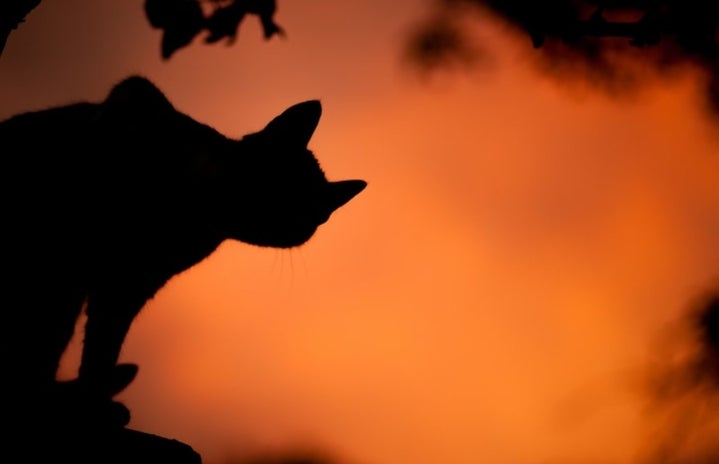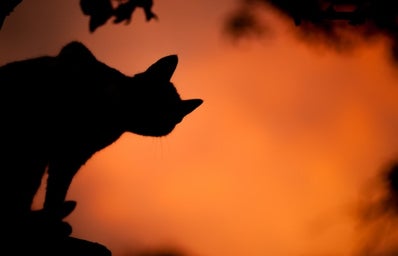Be it Rowling’s Harry Potter or Shakespeare’s Macbeth, I find it almost impossible to hear about witches without also hearing about cats. Apparently, cats and witches are the best of pals. But the association of felines with witchcraft is not innocent or coincidental at all. It is, in fact, deeply problematic. While we may smile and gasp with awe as we watch Professor McGonagall turn into a tabby cat, we must not forget how this stereotype of witches and cats harms both women and our furry friends.
To understand why and how this stereotype started, we have to get into the history of cats.
Cat-ology: Cats and Witchcraft
Cats have been around humans for thousands of years. They have been prevalent in a lot of folk tales, legends and mythology. We hear about them repeatedly in Egyptian Mythology but they were quite popular in other traditions too, for example, in Norse Mythology. In ancient Egypt, people believed that cats were magical creatures and brought good luck. Therefore, cats had a lot of value in Egyptian households. They often dressed them in jewelry and on the death of their feline friends, would mourn them deeply. And let me say, not a lot has changed in today’s modern world.
But why did cats get associated with witchcraft?
Before the middle ages and the practice of accusing women of witchcraft and killing them, people still believed in witches. But at that time, witches were much like hermits. They were people who had a lot of knowledge and could therefore perform magic. People would often visit these witches (who mostly stayed away from general people and lived in the woods) and ask for favors and cures. People used to maintain, if not a loving, but certainly a mutually respected relationship with the possessors of otherworldly knowledge. However, things changed when the Church intervened.
The Church convinced people that all things pagan were wrong and only the word of the Bible was to be followed. With this, they created and imposed a lot of stereotypes about witchcraft. It was propaganda against those who claimed to have more power and knowledge than the Church. Anyone who questioned them, especially women, would end up being accused as a witch and consequently dying. During the 15th-16th century, many women were killed by the Church.
The Two Enemies
It is important to see that all those who were targeted by the Church were those people who questioned them or raised questions. Authority has always despised people who are autonomous since all an authority wants to do is to control and suppress. Therefore, those accused of witchcraft were people who were independent.
Do you know any other animal who is known to be independent?
Yes, cats. There were many reasons why cats and witches were associated with one another. Cats were already quite popular in various mythologies and folklores. It didn’t help that they were pretty independent creatures who did not bow down to humans but came and went as they pleased. If anyone has owned a cat, they know what I am talking about. Cats are not like dogs or birds or fish or horses or any other animal humans have domesticated. You don’t own your cat but your cat owns you.
The Church also believed that witches carried out their ‘evil schemes’ during the night. Cats are also nocturnal animals. There were other myths like the Celtic belief that witches can transform themselves into cats eight times and if they did it the ninth time, they would be stuck as a cat. This might be where the whole ‘cats have nine lives’ story comes from. Some believed that witches would transform themselves into cats to get into other people’s houses and harm them.
Sadly, during the witch trials and executions of the middle ages, cats met the same fate as ‘witches’. Many of the people who were accused of witchcraft would have cats as their pets. These cats were thought to be ‘familiars’ who would do the bidding of their masters (this is extremely confusing since we all know that no cat would do the bidding on any human).
Today, many people hate cats because of the perpetuation of such old stereotypes. Since Western traditions claimed that black cats are evil, we see how black cats rarely get adopted in animal shelters. Not just cats but any woman (since women have been primarily targeted and accused as witches throughout history) who owns cats is also seen as a ‘crazy cat lady’. Yes, cat lovers are still considered crazy today. I will go even further and say that a woman loving cats is still considered to be some extended version of a witch by the larger social unit.
At the end of the day, I notice a lot of familiarity between the portrayal of witches and cats. People who were accused of witchcraft and their cute felines had similar fates. They were independent and intelligent beings who resisted authority merely by being autonomous and had to bear the wrath of institutionalized religion.
And so now when I will see a movie about a witch calmly petting a cat, I will know that this is a queen and her gorgeous pet and both of them deserve our love!


